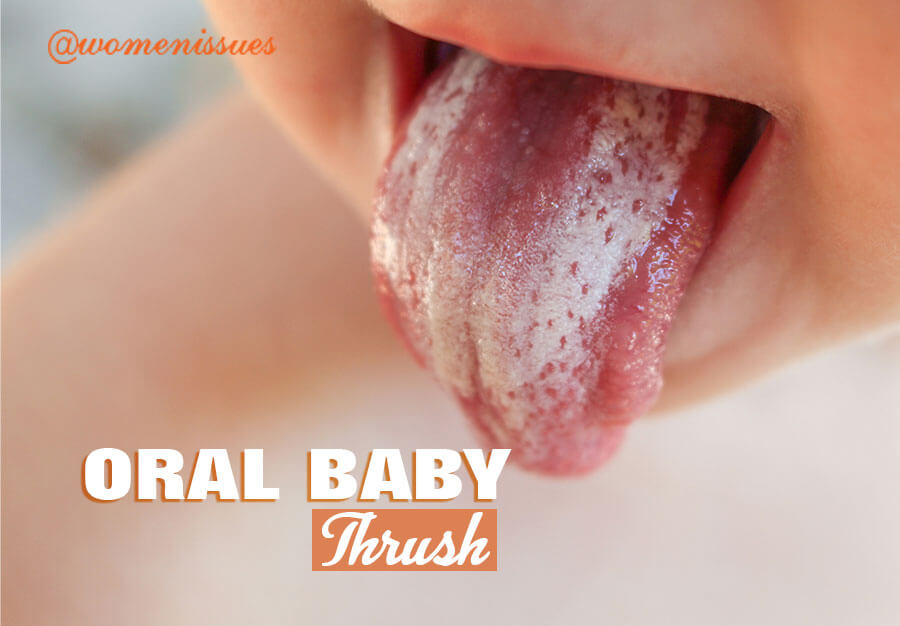WHAT IS ORAL BABY THRUSH?
Ever noticed a white coating on your baby tongue? That can simply be a milky tongue or it can be a sign of oral thrush. Oral baby thrush is a yeast infection in the baby’s mouth that appears as a white coating or patches. It is a common condition that affects infants under two months old. It thrives in moist warm environments making the mouth the ideal spot. Mothers notice a white coating on their baby tongue often, now how do you differentiate between the milky tongue and baby oral thrush?
Signs of a milky tongue
- the coating only appears shortly after breastfeeding, not throughout the day
- a gentle wipe will reduce the white coating showing the normal pink tongue
- the white coating restricts only on the tongue and no other parts of the mouth
Signs of thrush
- the white coating will resemble cottage cheese and appear throughout the day
- a gentle wipe will cause bleeding
- the white coating will be on the tongue, the inner cheek, lip, and the roof of the mouth
- wounds or cracks on the corners of the mouth
- red inflamed patches normally surround the white coating
- if it progresses to other parts, it will show red rashes in the diaper area
- there might be discomfort when breastfeeding or using a pacifier
What causes thrush and how do babies contract it?
Thrush is caused by yeast or fungus known as Candida albicans and it is found in both adults and newborns. This fungus can live on the newborn mouth or skin surface without causing thrush but under certain conditions, it will overgrow and become an issue. These conditions are the risk factors and that may include:
- premature babies- they are more likely to contract it than full-term babies
- the use of antibiotics- they may kill the bacteria that is responsible for managing the fungal growth
- use of medication that contains steroids
- compromised immune system
- pacifiers- too much sucking on pacifiers
- pregnancy- when the baby comes through the birth canal during delivery, they will pick up some of the fungi found there more especially if you suffered vaginal yeast infection during pregnancy. Vaginal yeast infection is actually a common pregnancy side effect.
How to treat it?
it is commonly nothing much to worry about as it is easy to treat with medication and in most cases, it can disappear from 1 to 3 weeks without treatment. However, call your doctor to prescribe the correct antifungal treatment to ensure the safety of your newborn.
Avoid reinfection
Reinfection may occur during breastfeeding if the nipple gets infection as well. If the nipple is affected it will also have nipple thrush whereby a mother may experience sore nipples that are pink, itchy with flaky appearance, and sharp shooting pain in the breast during and after feedings. Keep the nipple area clean and treat it as well to avoid passing the infection back and forth between you and your newborn.
Tips to prevent it
- change nursing pads after every feed and wear a clean bra every day
- keep your nipples clean and dry after every feed
- refrigerate milk directly after pumping if it’s not for immediate use
- wash your hands and baby’s hands regularly as they might like to suck on their hands
- sterilize everything that your baby is likely to put in their mouth like teethers, pacifiers, toys, breast pumps, bottles, and artificial nipples.
- avoid medication with steroids or antibiotics unless necessary.
You might not be able to prevent it during vaginal birth but with proper care, the risk can be reduced.
Complementary home remedies
- yogurt- if your infant can eat yogurt feed them unflavored and unsweetened. If they can’t eat yet apply it to the affected area with a cotton swab.
- virgin coconut oil- apply to white patches with a cotton swab
- baking soda- boil water, let it cool then add half a teaspoon of baking soda and wipe the solution in the baby’s mouth with a clean cotton bud
- tea tree oil- boil water, let it cool then add 1 or 2 drops of tea tree oil and wipe the solution with a clean cotton bud
- other remedies include saltwater solution, apple cider vinegar with water solution or you can also try to cut down on sugar in your diet.
check with your medical professional before using these home remedies alongside the prescribed medication.
Oral baby thrush can make breastfeeding unpleasant for both you and your baby. It is not recommended to stop breastfeeding. That can’t absolutely be the reason to stop breastfeeding and you need to keep the breast milk flowing. If it becomes too painful, you can express the milk for your baby or give shorter frequent feeds starting with the least painful side all the time. If you have enough privacy, you can keep your breast bra free for a while so the nipples can get some sunshine and stay dry to help with the healing. It is important to keep clean and dry because reinfection between you and your baby can make it difficult to get rid of and it can also affect other family members if you share bedding and other utensils.
Parenthood can come with a lot of challenges. These challenges like this one can be easily treated and/or prevented only with the right actions and attitude towards it. Thrush can only be developed if given the right conditions to thrive. Stay clean and stay clear.
**BABIES HAVE A WAY OF BRINGING US SO MUCH JOY, LET US PAY THEM BACK BY GIVING THEM THE BEAUTIFUL SMILE THEY DESERVE**



No Comment